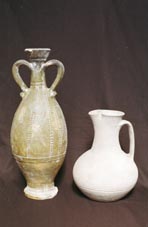Halls 22 – 23 The Varna Region During the
Period of the First Bulgarian Kingdom /681 –1018/
From the 4th century AD onwards the ethnic structure
of the territories on the western Black Sea coast became more and
more variegated. Alongside with the local Thracian population, as
a result of the barbarian invasions, groups of settlers coming from
the territories to the south of the Danube appeared. In this process
during the 6th century AD should be included the large Slavonic population
groups that settled permanently in the ancient Thracian lands. During
the 7th century AD here settled also the Proto-Bulgarians who established
a Bulgarian state recognized by Byzantium in 681.
The town life in Odessos was terminated
in the middle of the 7th century AD. According to the archaeological
investigations the surroundings of the town were populated by large
compact groups of Slavs and Proto-Bulgarians. The Byzantine chroniclers
Teofan and patriarch Nikiforus mentioned that after defeating the
Byzantine army at the mouth of the Danube in 681 the Proto-Bulgarians
headed by khan Asparukh reached "Varna, near Odessos". This was
the first time the name of Varna was mentioned and later on that
was the name given to the town that raised over the territory of
the old Odessos. To the south of the new settlement along the coast
of the bay was put up a defensive rampart in which a column with
the Proto-Bulgarian sign was built in.
The territories were densely populated by
Slavs and Proto-Bulgarians and that was confirmed by the numerous
villages and necropolises studied on archaeological excavations
to the west of Varna and in the
Devnya valley. In one of the Proto-
Bulgarian settlements in the Devnya valley was found a unique model
of a Proto-Bulgarian jurta house. In comparison to the previous
epoch the funeral inventory was totally changed. The pottery was
much cruder with totally different form and decorative ornaments.
Some of the vessels were used for burial urns.
Cremation was practiced alongside with the
traditional burial. The decorations and the everyday objects in
the lower showcases are mainly from these necropolises.
The belt and sling decorations /metal buckles,
applications and tabs/ are elements of the Proto-Bulgarian military
equipment of the Old Bulgarian army.
After the adoption of Christianity in 865 during
the rule of Knjaz Boris I, monasteries were put up in the district
of Teke Karaach near Varna and the village of Ravna by the town of
Provadija. Those were important religious and educational centers.
The condition of the Old Bulgarian culture in the region is illustrated
by inscriptions and carvings on stone walls, table utensils and architectural
details.
Of special interest are the two lead seals of
the Bulgarian rulers, Knjaz Boris I and Czar Simeon discovered in
a necropolis in a monastery from the surroundings of Varna. |











